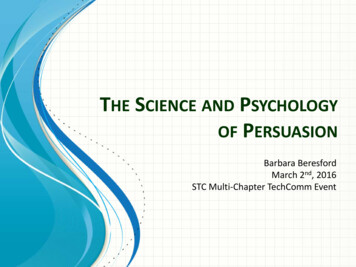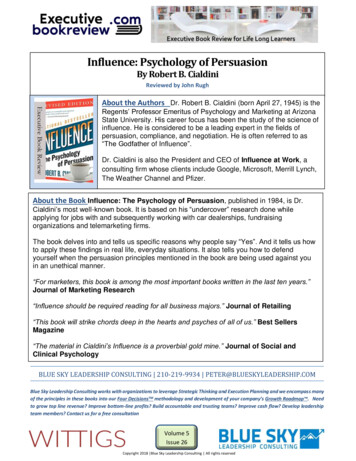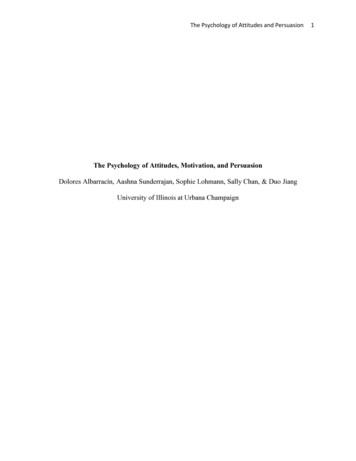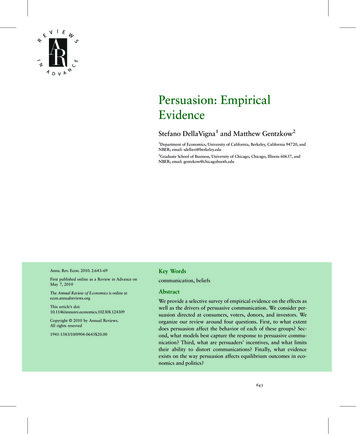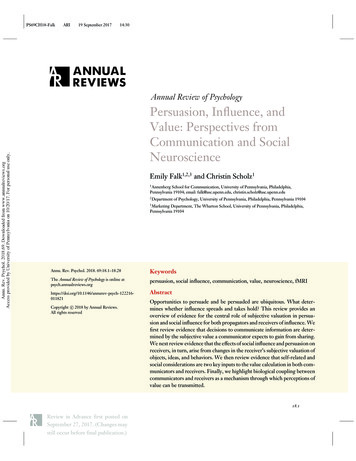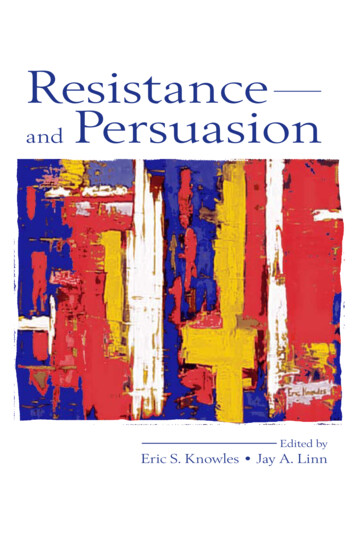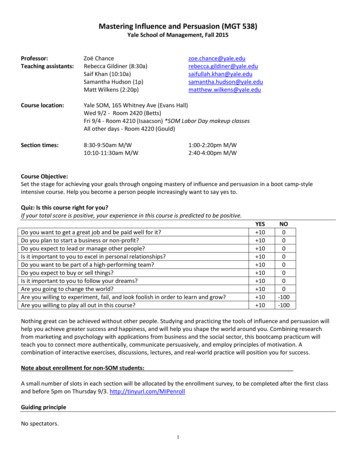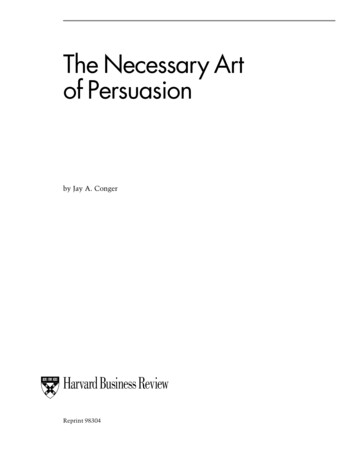
Transcription
Influence: The Psychology Of PersuasionBy Robert B. CialdiniContent *** Readability *** Clarity & Structure ***IN A NUTSHELLCialdini has identified 7 key influencers of persuasion (based on 35 years ofevidence based research): Weapons of influence (aka reason why),Reciprocation, Commitment & Consistency, Social proof, Liking, Authority andScarcity.Paul Arnold ConsultingPLANNING - FACILITATION - TRAINING27 Kingsfield Avenue, Harrow, Mddx HA2 6AQ07768 775988 paul arnold@me.com
1) Weapons of InfluenceReason Why - Attaching a reason to a request increases the success rate: “Ihave 5 pages, can I use the Xerox machine before you because I’m in a rush” had asuccess rate of 94% vs.60% success rate when no ‘reason why’ was given.Showing potential customers the most expensive item first then workingdownwards in price leads to an increase in the amount spent (as the nextproducts seem cheaper in comparison).2) ReciprocationSocial obligations - Humans inherently dislike being indebted to someone, somuch so that often a small gift or favour will lead to a larger reciprocalresponse. This fact is exploited worldwide, e.g. Hare Krishna’s who offer a‘gift’ of a flower when soliciting for donations (which they refuse to take back).As the receiver cannot unburden themselves from the subconscious debt, thesocial pressure to donate leads to a higher donation rate than merely solicitingalone. An Indian supermarket sold 1000 of cheese in a few hours by invitingcustomers to slice their own free samples.Reject & Retreat – This technique consists of first demanding a high price (or alarge favour), then waiting for it to be rejected, only to follow this demand upwith a smaller one, (that you really wanted all along). Quote from a child: ‘Ifyou want a kitten, first ask for a pony’ (Ed).3) Commitment and ConsistencyWe tend to remain consistent to our commitments, once we have made them(consistency is a socially attractive trait). Studies found that when people areasked if they would vote led to an increased likelihood to follow-through. This iswhy it is recommended to write down/verbally state our goals, as we thenstand a much greater chance of sticking to them (cf http://www.stickk.com - Ed)Households were called and asked to predict what they would do if they wereasked to volunteer for three hours to collect for charity. Three days later, theywere recalled and asked to collect for charity. This led to an increase in thenumbers of volunteers by 700%. Its use in business was put succinctly by anarticle in American Salesman. “When a person has signed an order for yourmerchandise, even though the profit is small, he is no longer a prospect - he is acustomer”Living up to our identity - “We are what we repeatedly do”- Aristotle. We will actin ways that are consistent with our identity, beliefs and values. AmericanPaul Arnold ConsultingPLANNING - FACILITATION - TRAINING27 Kingsfield Avenue, Harrow, Mddx HA2 6AQ07768 775988 paul arnold@me.com
POW’s in Korea who were made into collaborators, started co-operating whenthey were labelled and classed themselves as a collaborator.4) Social ProofPeople are influenced by what others do. At an unfamiliar event or situation,we look to others on the correct etiquette. This is exploited for example, inbars or at church collections. The tips/donations are sometimes ‘salted’ byhaving money already placed there or having a stooge give money to stimulateothers to tip. This effect is amplified by how similar the person whose actionswe are watching are to ourselves.5) LikingAs a rule, we prefer to say yes to the request of those we like over those wedon’t. There are several key properties that determine our view of people:Attractiveness, similarity, compliments, contact & co-operation, conditioningand association. Studies found we automatically attribute traits such as talent,kindness, honesty and intelligence to attractive people. It is no co-incidencethat ‘attractive’ political candidates received two and a half times the votes ofunattractive rivals.We like people who are similar to us, with the same views, interests, beliefsand values. We therefore need to find areas of shared interest to increaserapport and connection.Joe Girard won for twelve years straight the title of ‘Number one salesman’,selling on average five cars or trucks a day. His formula behind his successwas simple; he provided a fair price, and someone they like to buy from. Oneof his key tactics however was to employ the use of compliments. Every monthhe sent every one of his 13,000 former customers a holiday greeting cardcontaining a personal message. The holiday greeting changed from month tomonth (Happy New Year, Happy Easter etc.), but the message printed on theface of the card never varied. It only read ‘I like you’.Endless chain - When a salesman approaches the person recommended,saying “your friend recommended this for you” it increases the chance they willmake a purchase. Turning the salesman away is difficult as it’s like rejectingone’s friend.Paul Arnold ConsultingPLANNING - FACILITATION - TRAINING27 Kingsfield Avenue, Harrow, Mddx HA2 6AQ07768 775988 paul arnold@me.com
6) AuthorityThe greater the perceived authority of a person, the more likely people are tocomply (cf the Stanley Milgram experiments).Hospitals have a 12% daily error rate. This is because, nurses and juniordoctors will very rarely challenge the decision made by an authoritative figure,despite receiving potentially lethal, or bizarre requests.We often perceive and interact with people with authority differently. The morepower a person is deemed to have, the more generous people are whenestimating their height, and the more cautious we are with our conversations.7) ScarcityWe are more motivated to act if we think we are going to lose something, thanif we are to gain something. ‘Save 50 a month on ’ would not be as effectiveas ‘You are losing 50 a month on ’. An item that is scarce is more desirablethan one that is freely available.The high pressure environment, like an auction can lead an item being sold foran elevated price as the buyers fear losing out to another person.CRITICISMThis book was a pre-curser to Behavioural Economics and was one of theclassics in business. Its examples may be a bit dated but its core principlesremain as powerful. Overall, I feel the latest BE books have moved the subjecton.Paul Arnold ConsultingPLANNING - FACILITATION - TRAINING27 Kingsfield Avenue, Harrow, Mddx HA2 6AQ07768 775988 paul arnold@me.com
How to get the bestout of your agenciesWhen properly managed, Agencies can create a step-changein the fortunes of the business. But if the relationship is notworking it creates stress, eats time, and leads to suboptimalwork.Having worked for 25 years in advertising (specializing inrelationships) I can help Clients get the best out of theiragencies. This can either take the form of consultancy or a 2day role-reversal workshop.Paul Arnold ConsultingPLANNING - FACILITATION - TRAINING27 Kingsfield Avenue, Harrow, Mddx HA2 6AQ07768 775988 paul arnold@me.com
Influence: The Psychology Of Persuasion By Robert B. Cialdini Content *** Readability *** Clarity & Structure *** IN A NUTSHELL Cialdini has identified 7 key influencers of persuasion (based on 35 years of evidence based research): Weapons of influence (aka reason why),
